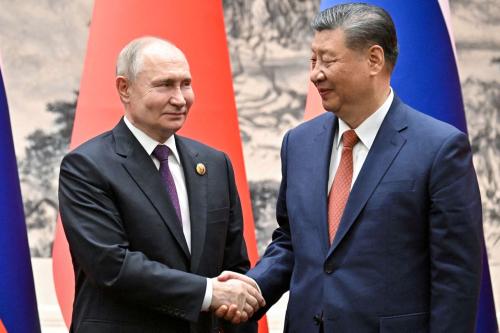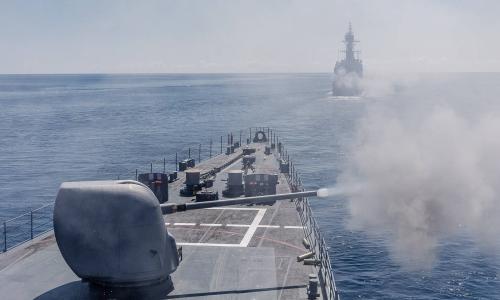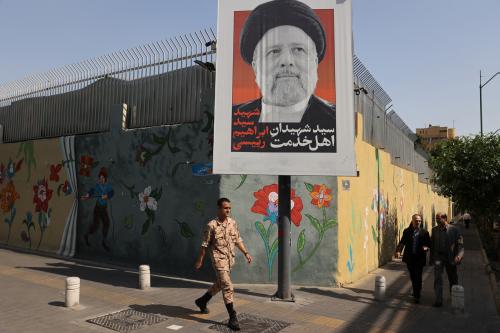In the Afghanistan strategy debate, two basic options have crystallized: a militarily beefed-up counterinsurgency or limited counterterrorism through selective strikes, many from the air and offshore. Public support seems limited for the former. Given the importance of the on-ground human intelligence, the effectiveness of the latter is questionable and, anyway, narrow counterterrorism was essentially the U.S. policy in Afghanistan until 2005 while the Taliban grew and al Qaeda regrouped. Hence strategists are proposing options that lie seductively “in the middle.” But these are unlikely to reverse the deteriorating security and produce a self-sufficient Afghan government.
The first middle option is the continuation of the current mission with current resources. As the remainder of the 21,000 U.S. troops approved earlier deploys to Afghanistan, a reversal of the inauspicious trends may yet emerge. But the odds are low: The current ISAF levels are simply not sufficient to provide necessary security for even large cities, such as Lashkar Gah and Kandahar. As allies start peeling off next year, the struggle to maintain even current security will intensify. Moreover, parts of Afghanistan previously thought immune from Taliban destabilization – especially the north – have seen a disturbing rise of Taliban activity. The Taliban does not have to hold there to generate enough insecurity to halt economic development and provoke ethnic violence. Unless the Taliban commits some egregious mistakes, staying at current levels means drift to more insecurity and losing the patience of the Afghan people.
The second option is Afghanization I: vastly speeding up the production of the Afghan National Army and the Afghan National Police and delaying any U.S. troop increases until then. Indigenous forces are optimal for fighting a counterinsurgency and ultimately necessary for success. But there are limits to how fast they can be produced in terms of trainers available and the time it takes to generate moderately capable forces. Even the current ANA has logistics, planning, command, and operational tempo problems. Without U.S. units available for partnering up, these problems are going to grow for new units. Furthermore, in the south’s violent provinces, the ANA and ANP retention is only 20-40 percent. Finding recruits to even replenish retention losses will be a challenge. And, as the state of the ANP shows, badly trained and predatory forces are worse than no forces. Because of inadequate, too-short training and other problems, most of the ANP are seen as thieves. Having 130,000 thieves instead of 80,000 ones will only fuel the insurgency.
Afghanization II, the third option, involves either reviving the old British approach of delegating responsibility for security to Pashtun tribes or standing up Anbar-like militias. Both look a lot like the USSR’s last desperate measures in Afghanistan in the late 1980s. Many Afghan tribes today are weak, and their leadership structures are destroyed. The tribes’ inability to carve up Afghanistan into stable fiefdoms after the Soviet withdrawal precipitated the rise of the Taliban. When the British tried the tribal approach in Musa Qala a few years ago, the district was rapidly overrun by the Taliban. Attempts to raise lashkars in Pakistan have largely resulted in the tribal forces and vestiges of the tribal leadership decimated by Taliban. While some powerbrokers in Afghanistan’s south are volunteering to raise militias to make a hefty profit, unlike in Iraq, there is no general tribal upwelling to take on the Taliban. Tactical gains are unlikely to materialize, and medium-term problems of stable legitimate governance will arise.
Option four is negotiating with the Taliban. At the strategic level it means striking a deal with the Quetta shura. As Mullah Omar made clear, he is only interested in negotiating about how fast NATO will withdraw and will not settle for less than full participation in the Afghan government and dominance of the south. Talks about strategic negotiations only embolden the Taliban. At the tribal and the individual levels, the key obstacle is guaranteeing security to those who leave the Taliban. Its policy toward defectors is clear: kill them. The resulting deterrent effect is why so few have left, and without enough Afghan or NATO forces to protect them, few will risk peeling off.
Option five is do economic development first to persuade the population that life is better without the Taliban. Most Afghans think that. But development cannot be accomplished without security. One reason why development has been so slow is that Taliban actions grounded many projects. As long as locals and international investors do not believe in a safe, stable future, they will liquefy their assets and make economic choices inconsistent with development.
The same is the problem with putting anti-corruption and governance ahead of security, option six. Without progress on delivering better governance, military increases will not produce success; and how to improve governance is the single most vexing question. But without a reasonable expectation that security will materialize, better governance will not germinate. If predatory, abusive, and corrupt elites calculate that greater stability is not in the making, they are going to operate on short-term horizons and simply speed up rapacious accumulation of profit and power.
The final, middle option is bankrupting the Taliban by turning off its money. The Obama administration already wisely rejected poppy eradication as a way to do this. But beyond a few very tactical successes, there is simply no case of defeating a large-scale insurgency by interdicting its money. The Taliban has a highly diversified and dispersed revenue portfolio in Afghanistan and abroad, the prospects for quickly finding enough of the money and being able to switch them off are small.
We should not delude ourselves that the middle is the golden path. Instead, we need to decide how much we care about the stakes and whether we are willing to resource the mission properly to achieve them. If not, cutting losses now may well be preferable to depleting blood and treasure while caught up in a downward spiral. It will only become harder to portray a later pullout as a strategic choice rather than defeat.



Commentary
It’s All or Nothing in Afghanistan
October 12, 2009